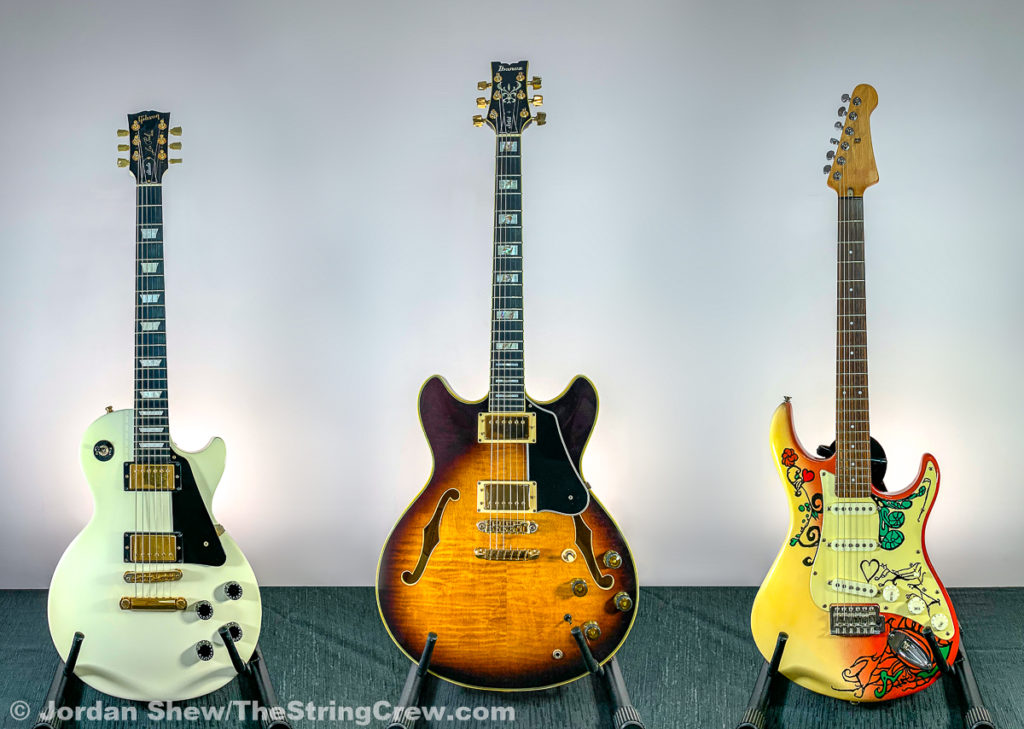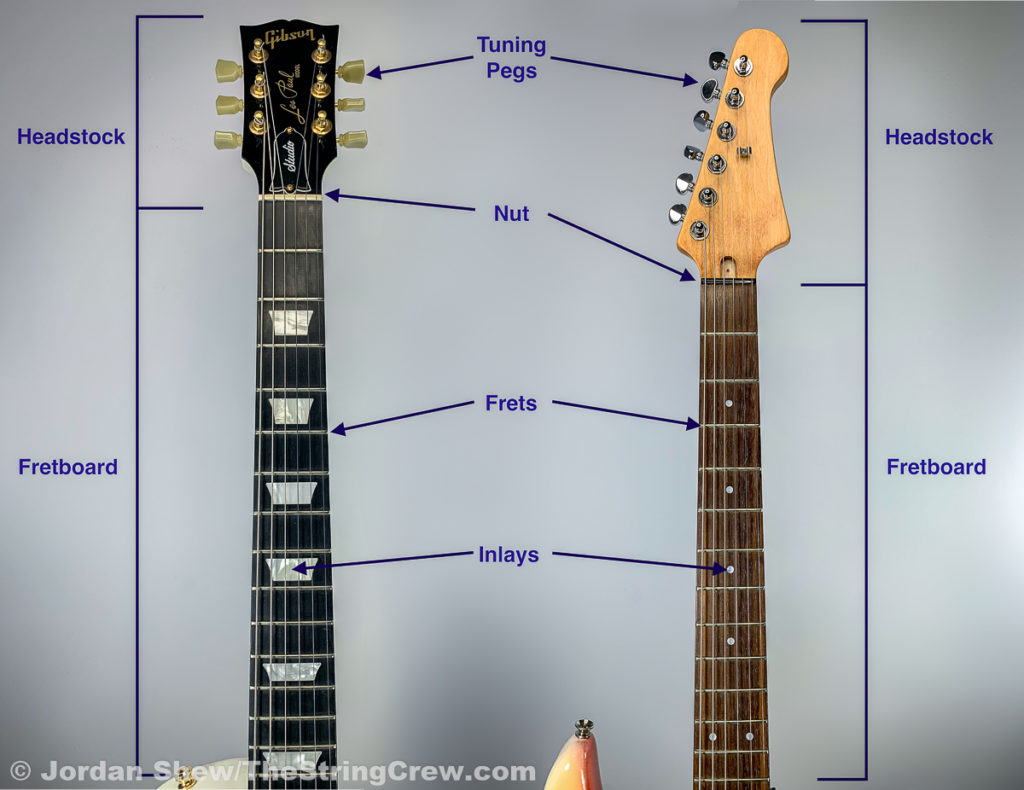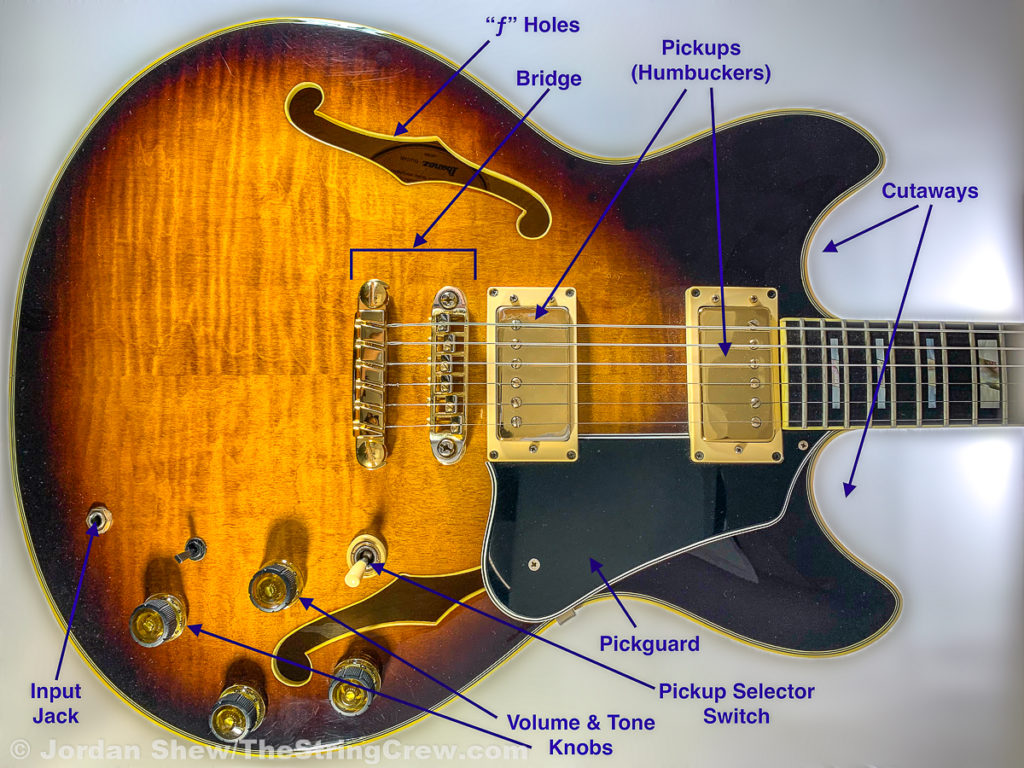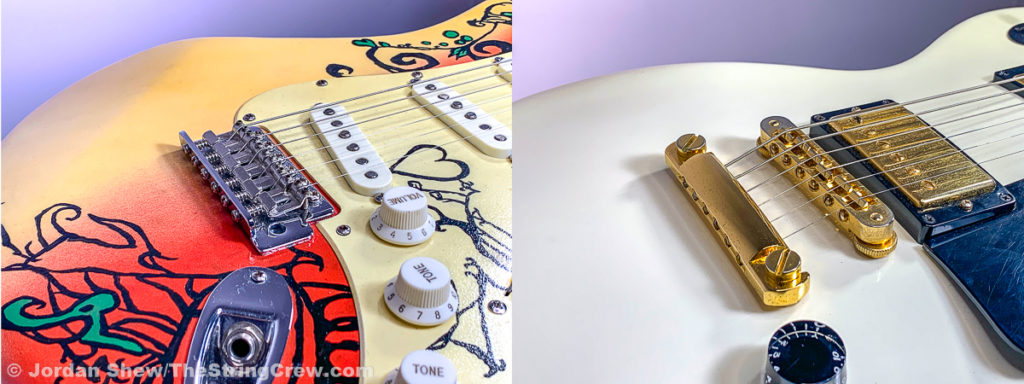Electric guitars are wonderful, diverse instruments. They come in all shapes, sizes and configurations, delivering all sorts of tones and timbres.
It can be intimidating to try and figure out the purpose of all the different things on an electric guitar, but fear not. The parts of an electric guitar are fairly straightforward – you just need a good guide!
If you’re new to the electric guitar, or are looking to learn a bit more about it, this guide will set you on the right path of understanding the key components and functions of the different electric guitar parts.

Table of Contents
Overview
This guide will outline the common anatomy of the electric guitar.
The picture below shows three common styles of guitars. Even though they each look pretty different, they all share core components that allow them to function in the same way.

We will start by looking at the top of the guitar (as pictured) and work our way to the bottom, naming each of the different components of an electric guitar and explaining its function.
The Headstock

The headstock is the part of the guitar at the end of the neck, as indicated in the picture above.
If you are right handed, this means that this section will be on your left side when playing and played with your left hand (and vice versa if you are left handed).
The headstock is home to two major components: the tuning pegs and the nut. Most guitar makers will add their company logo here to easily identify the brand.
On many guitars, the serial number can also be found on the rear of the headstock (either printed or stamped in the wood).
The Strings
Okay, so strings are not strictly part of the neck and headstock, but are an important part of the guitar nonetheless.
Most electric guitars are just good old fashioned 6-strings, but once you get into a more niche area, like metal guitars, there are variations with more than six strings.
Electric guitar string sets generally consist of three wound strings for the lower pitched notes and three plain strings for the higher three strings.
You can learn all about the different types of guitar strings here. In short, for this article, strings can be made up of multiple materials, and commonly include steel, nickel, brass or cobalt in their construction.
Different materials will have a unique tone and feel, and can have a large impact on the guitar’s sound.
Strings are the most easily customizable part of the guitar, and they have a profound impact on the sound. Even the same brand/variety and gauge will sound vastly different when comparing old versus new.
- Read More: How Often to Change Guitar Strings
String gauge, or thickness, also plays an important role in the guitar’s action and tone. A “standard” set of strings are usually sold as .010 to .046 gauge, and is a good balance of playability and tone.
Light gauge string sets (generally sold in sets from .009 to .042) mean that all of the strings are thinner, resulting in an easier action (meaning the ease of playability of the strings) for fretting and bending.
However, there is a tradeoff here as lower gauge strings generally lack the depth of tone found in higher gauge strings. There are also heavier sets of strings that cater to players who want a better tone more than easy playability.
Custom string sets are also available that blend gauges to provide some compromise between the lower strings and higher strings. You can learn more about light versus medium guitar strings in this other article.
The Tuning Pegs
The tuning pegs are responsible for affixing the string to the headstock, and provide the ability to vary the string’s tension, which in turn, affects the pitch (tuning) of the string.
There are two common arrangements of tuning pegs: three on each side of the headstock (as seen above on the Les Paul to the right), and six inline along the top.
The Nut
The nut is a small saddle (often made of bone, plastic, graphite, metal or ebony) that the strings sit in at the intersection of the headstock and the fretboard.
The nut can be thought of as “fret zero” (read on to learn more about frets), and is a terminal end of the vibrating section of string.
Each string sits in a slot in the nut, and each string should be able to move freely through its slot. The nut is a very important component that plays a critical role in both the action and the strings’ tone.
The action is affected by the height of the nut and the geometry of the slots, and the tone is most affected by the nut’s material, as well as the geometry of the slots.
The Neck
The neck is the portion of the guitar where the frets are located. For a right handed guitarist, the neck is held using the left hand. The guitarist uses their fingers to press on the strings to play different tones/notes and, if multiple strings are pressed, chords.
Necks are often made of hard, durable wood, such as maple or mahogany. The back of the neck is carved into a specific profile that affects the feel and playability of the guitar.
To envision the neck profile, imagine taking a cross-section of the neck, parallel to the frets. This cross section (called the profile) affects the feel of the guitar in the player’s hand.
There are many different types of profiles that cater to any hand size and playing style. One of the most popular neck profiles is the “C” profile, which is suitable for most play styles and hand sizes.
Read More: Can You Play Guitar with Small Hands?
Necks are made up of a few key components: frets, the fretboard (or fingerboard), inlays and the truss rod.
The Fretboard and Frets
The fretboard is the front part of the neck that the frets sit on. Frets are thin pieces of metal that are embedded into the fretboard at very precise intervals that allow the player to play different tones on the same string.
Fretboards can be an integrated part of the neck (one-piece neck), or a thin piece of wood glued onto the top of the neck (two-piece neck).
One-piece necks (meaning the neck and the fretboard are carved from a single piece of wood) are usually made out of maple. These necks can be more expensive than two-piece necks, but offer great stability and tone.
Two-piece necks are most common and can be made out of many different combinations of wood. Common fretboard wood on two piece necks include ebony, rosewood and maple. Apart from aesthetics, each wood imparts a certain feel and tone into the neck.
Frets come in different materials and sizes that affect the feel and the tone of the guitar. Generally speaking, larger frets have better tone and easier action, but have less precise intonation (the accuracy of the pitch when a note is played while fretted).
Large frets really shine when playing lead melodies, single notes, and bends. Smaller frets, on the other hand, often have more precise intonation but can be more difficult to play, and are often better in situations where the player is chording (versus playing lead/melody lines).
Inlays
Inlays are the shiny bits of different material that are embedded in the fretboard. Common materials include plastic, mother of pearl, abalone, or various exotic woods.
Inlays can be simple in shape (such as circles, trapezoids, or rectangles) or very intricate and complex. Generally speaking, the more complex the inlay and/or more exotic the material, the more expensive the guitar will be.
Apart from aesthetics, inlays are typically placed on specific frets so that the guitarist can quickly look at the fretboard and instantly know which frets are which. Inlays are most often found on frets 3, 5, 7, 9, 12, 15, 17, 19, 21.
Occasionally there is also an inlay on fret 1. When dot inlays are used, the 12th fret is almost always marked with 2 dot inlays. The 12th fret is important, since it is geographically the center of the vibrating portion of the string, and one octave above the open string’s note.
On most necks, there are also side dots on the top side of the neck so that they are easily visible when looking down onto the neck while playing. These side dots are placed at each fret that typically contains inlays.
Like the inlays, these are extremely helpful indicators to locate frets quickly when playing. The 12th fret’s side dots are almost always marked with two dots.
The Truss Rod
The truss rod is a threaded metal rod that runs through the length of a guitar’s neck that affects the action of the guitar, and amount of bowing or relief in the neck. Bowing or relief are the terms used to describe the overall “straightness” of a neck.
A neck in perfect playing condition has a slight bit of relief (the neck is slightly concave when looking down the frets along the length of the neck), and an easy action (meaning the frets are easy to press) with no fret/string buzz.
A neck that has a back-bow or too little relief will generally produce a buzz when the strings are played. This means that the neck is either straight or slightly convex, meaning that the frets in the middle of the neck are too close to the strings.
A neck that has an up-bow or too much relief will appear a bit concave, meaning that the frets in the middle of the neck will be comparably further from the strings. This generally means that the guitar will have a “high action,” and may take a lot of strength or effort to play.
The truss rod is usually accessed at the headstock or at the body end of the neck. Guitars often come with a specialized tool to adjust the truss rod.
If you are unfamiliar with how to adjust a truss rod, this is a modification that is best left to the professionals. The truss rod can significantly change the internal tension in the neck, causing irreparable warping or damage.
Read More: Why Do Guitar Necks Warp?
If you suspect that your guitar is having truss rod issues, or the action seems poor, take it to a luthier or repair shop for an assessment. They will have the skills, tools and know-how to get your guitar in top playable shape.
The Body

The biggest section of the guitar is called the body. An electric guitar’s body can be solid wood, chambered, semi-hollow or hollow.
The type of wood used on the guitar body can have a large impact on the tone, as well as the aesthetic. The body is also typically where you’d find awesome guitar stickers – if any are applied!
Another factor that can affect tone, playability, and aesthetic is whether the guitar body is single cut or a double cut (meaning wood has been “cutaway”).
There are a few major components on the guitar body that are important to identify and understand.
All of an electric guitar’s electronics are housed within the guitar body, including the pickups, volume and tone knobs, pickup switch, and input jack. The body also houses the bridge, pickguard, and strap buttons. We’ll take a look at each part in more detail.
The Pickups
Aside from the strings, pickups are the components that have the greatest effect on the sound that an electric guitar outputs.
Pickups are transducers that transform the vibration of the metal guitar string into an electrical signal that can be amplified by a guitar amplifier.
Pickups are made from magnets and copper coils. The type of magnets, number of copper wounds (among other material and construction factors) play a large role in the variation of tone that can be produced by pickups.
There are two types of pickups: single coil (as seen on the Strat-style guitar) and humbuckers (seen on the Les Paul and AS200).
Humbuckers are usually larger than single coil pickups, as they are most commonly made from two single coils placed side by side. Tonally, single coil pickups and humbuckers vary greatly.
Single coil pickups are generally brighter and more articulate than humbuckers, however they often suffer from more noise and generally produce a thinner overall tone than a humbucker.
Humbuckers, as the name might imply, generally produce much less noise than single coil pickups, due to the fact that they are made up of two single coil pickups in an arrangement that “cancels out” the hum.
Humbuckers generally have a thicker and smoother tone than single coil pickups. Then there is different locations for pickups – we dive into the differences between Bridge and Neck Pickups in another article!
Volume and Tone Knobs and the Pickup Switch
The knobs on an electric guitar control the volume and tone levels of the guitar’s pickup output.
The pickup switch selects which pickup is in use, and depending on the model of guitar, selects which volume and tone knobs are active.
The Input Jack
The input jack is the hole in the guitar body that you plug the guitar cable into when amplifying your guitar. Depending on the model of guitar, the input jack can be located on the front of the guitar or the bottom edge of the body.
The input jack is almost always located in the same region of the guitar, and in some guitars (often acoustic guitars with pickups), the bridge-side strap button doubles as an input jack.
- Read More: Can You Play Electric Guitar Without An Amp?
The Bridge

There are many different types of electric guitar bridges. The core function of the bridge is to affix the string to the guitar body and set the intonation of each string.
The string sits on an adjustable saddle, which is the point of contact where the vibrating portion of the string touches the bridge. Moving these saddles changes the intonation of the strings.
If you find that your guitar becomes out of tune as you play further up the neck of the guitar, this may be due to an improper setup of the saddles.
Getting a guitar “set-up” often involves the saddles being adjusted so that when the 12th fret of any string is fretted, it is exactly one octave above the open string’s pitch.
Saddles are also a very important component that impacts the guitar’s sustain (how long a note resonates) and tone.
Higher quality saddles allow the string to resonate more freely (increasing the possible length of a note), which in turn, allows for more harmonics to develop (ie. better tone).
A few common types of electric guitar bridges are the tremolo bridge (seen on Stratocasters and Strat style guitars) and the Tune-o-matic floating bridge (seen on most Gibson style guitars).
- We’ve actually got a whole detailed article on the different types of electric guitar bridges, if you’re interested. We’ll summarize below!
Tremolo bridges require a chambered back in the guitar body to allow the bridge to tilt back and forth, allowing the pitch of all the strings to modulate. The bridge can be modulated using a whammy/tremolo bar that screws into the front of the bridge.
On these bridges, the strings are typically threaded through the back of the guitar, through the bridge and saddles.
Tremolo bridges and variations of it (such as Floyd Rose bridges) are very common and generally offer the best tuning stability when the whammy/tremolo bar is not used.
Tune-o-matic bridges are floating bridges, meaning that the end section of the bridge that holds the strings is held in place by the tension of the strings. The saddles on a tune-o-matic bridge are held in a separate portion of the bridge, making this a two-piece bridge.
These styles of bridges generally offer superior tuning stability, since it is a fixed style of bridge (meaning there is no way to modulate the string’s pitch via the bridge).
The Pickguard
The pickguard is a thin piece of material (usually some sort of plastic) that is installed under the strings and pickups to protect the guitar’s finish from pick scratches. You can learn more about guitar picks here.
On most Gibson style guitars (and guitars where the electronics are hidden within the guitar body) the pickguard mostly serves as an aesthetic choice to preserve the guitar’s finish.
On Telecasters, Stratocasters, Strat-style guitars, the pickups, tone pots and switches are often affixed directly to the pickguard.
Therefore, on these guitars, the pickguards are used to house and cover the electronics and wiring, while also providing some electromagnetic (EM) and radio frequency (RF) shielding.
Strap Buttons
Strap buttons are used to affix a guitar strap to the body of the electric guitar.
There are two strap buttons on a guitar: one on the bridge end of the guitar (in line with the neck on the side of the guitar), and one on the guitar shoulder or top cutaway (the portion of the guitar close to the neck on the upper part of the body).
Strap buttons come in all shapes and sizes, and there are even models of strap buttons that lock.
Strap locks are extremely useful for any guitarist when playing live (to avoid strap slippage and guitar drops). Locks are especially for guitars where the strap buttons tend to release due to poor placement.
- Read More: How to Attach a Guitar Strap
Related Articles
For more talk about everything electric, here are some other popular articles:
Conclusion
There are so many different variations of electric guitars, that you could easily write a book on all of the differences.
Hopefully this article was useful to shed some light on the vital and common components of the electric guitar and their basic functions.
\m/
-J
